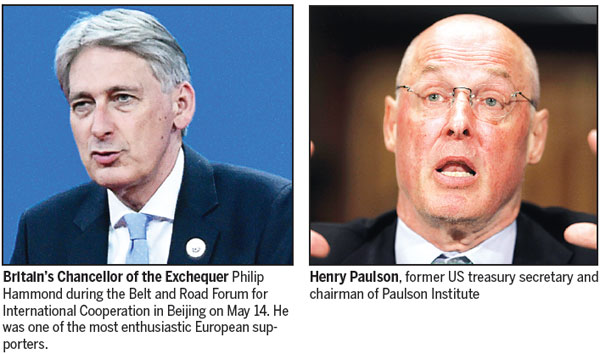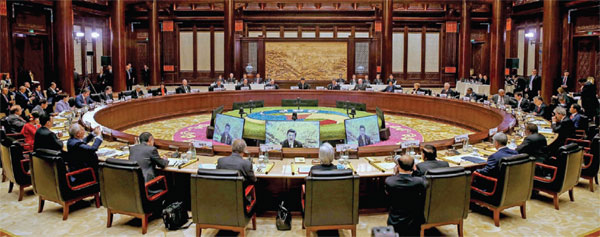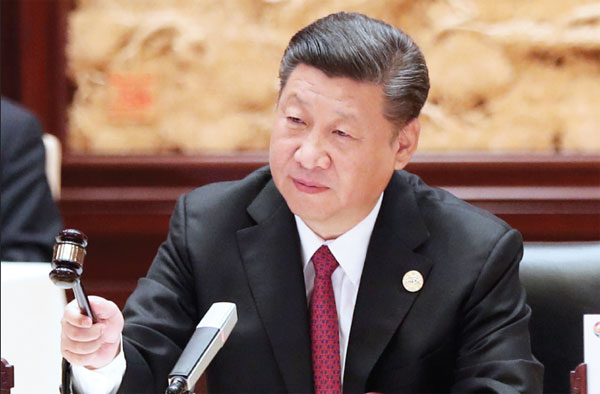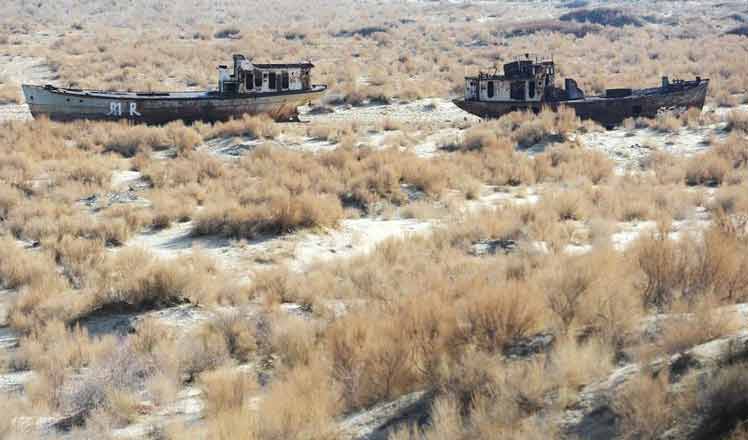Global vision
Though originating in China, the Belt and Road Initiative belongs to the whole world, President Xi says
A new form of globalization based on investment in infrastructure and greater connectivity between countries has received the backing of more than 100 countries.
China's Belt and Road Forum for International Cooperation, which was attended by 29 foreign heads of state and government including Russian President Vladimir Putin and Turkish President Recep Tayyip Erdogan, concluded in Beijing on May 15.
The final communique called for a "shared commitment to building an open economy, ensuring free and inclusive trade (and) opposing all forms of protectionism."

China pledged an additional 100 billion yuan ($14.49 billion; 12.57 billion euros; £11.20 billion) to the Silk Road Fund, which was originally launched in November 2014 with an initial contribution of $40 billion.
It also directed extra funds to China's two big policy banks, with the China Development Bank receiving 250 billion yuan and the Export-Import Bank of China 130 billion yuan to set up special lending facilities.
The initiative is likely to attract major private sector funding as well as that from multilateral development institutions.
President Xi Jinping made it clear that although Belt and Road was originally China-inspired, it is now firmly a global initiative and open to all.
"The Belt and Road development does not shut out, nor is it directed against, any party," he said.
"Though originating in China, the Belt and Road Initiative belongs to the whole world. Its development goes beyond regions, stages of development and civilizations."

China is set to host a second summit in 2019 to measure and monitor progress of the initiative, which was proposed by Xi in 2013.
Wang Yiwei, director of the Institute of International Affairs and the Center for EU Studies at Renmin University of China, says the forum marked the point where Belt and Road became a truly international initiative.
"It can no longer be regarded as bilateral but is very much multilateral, and it came up with a consensus for real action. This summit has sent out a signal that it welcomes all the countries in the world to participate."
Wang Huiyao, a counselor to the State Council, China's Cabinet, and founder and president of the Center for China and Globalization, China's largest independent think tank, agrees the initiative had come of age.
"It has been upgraded from being about 65 countries on a series of routes to a global initiative. It is no longer just a Chinese project, but one taken up by others across the world who have now come on board."
Martin Jacques, the journalist, academic and author of the best-selling When China Rules The World, who also spoke at the forum, says China's initiative was presenting a very different form of globalization.
"Western neoliberal globalization as made very clear by (former US president) Bill Clinton in the 1990s was about opening up markets around the world for Western products and investments and making the world more Westernized," he says.
"The Chinese approach is about improving the lives of those in the developing world, where 85 percent of the world's population live, involving mainly State-led investment in infrastructure to drive economic growth. It is how China developed itself."
A number of high-profile politicians spoke at the forum. UK Chancellor of the Exchequer Philip Hammond was one of the most enthusiastic European supporters. He said Britain after Brexit would now be a natural partner for the initiative.
"As we embark on a new chapter in our history, as we leave the European Union, we want to maintain a close and open trading partnership with our European neighbors and at the same time pursue our ambition to secure freer trade agreements with new partners and old allies alike," he said.
"Our ambition is for more trade, not less trade, and China clearly shares this ambition."
Zheng Bijian, the president of the Institute of National Innovation and Development Strategies, told a thematic session on think tank exchanges at the forum that the initiative reflected the new realities of the world.
He pointed out that developing countries made up just 36 percent of the world economy by purchasing power parity in 1980, but by next year they will make up 59 percent of it, with developed countries contributing only 41 percent.
"It will be the developing countries (in their need for infrastructure and other investment) that will be continuing to drive global economic growth in the second and then the third and fourth decades of this century. This will lead to a new phase of globalization.
"It is not a zero-sum game. People fail to understand the core meaning of the Belt and Road Initiative is cooperation. It is a grand vision."
Former Australian prime minister Kevin Rudd, speaking in the same session, said the initiative would strengthen regional and global cohesion.
"If it is operated properly, it will become a new bridge between the East and West for both cooperation and exchanges and an end to division."
One thing clear was that the initiative has the potential to provide a boost to all parts of the world, including Europe.
One example is China investing through its Silk Road Fund in a network of five ports in the northern Adriatic, including the Italian ports of Venice, Ravenna and Trieste and Koper in Slovenia and Rijeka in Croatia. This will give it an alternative route into north and central Europe, rather than just the port of Piraeus in Athens.
"China's 21st Century Maritime Silk Road is very important to Italy because it ends up in the Mediterranean and Italy is in the center of the Mediterranean," says Nicola Casarini, head of the Asia program at IAI, the leading Italian foreign policy think tank based in Rome.
"Our ports provide an alternative route for goods bound for central and northern Europe."
Africa also remains key to the initiative, with a number of the continent's leaders attending the forum.
One new tie-up with the continent was an example of how Belt and Road is not just about physical connectivity but also new technology.
Huawei, China's telecommunications giant, signed a collaboration agreement with the Kenyan government at the forum to help it build the infrastructure for using cloud technology for government services. This is part of Kenya's Vision 2030 to develop an ICT (internet cloud technology) industry.
Kenyan President Uhuru Kenyatta said he welcomed the new partnership with Huawei, which has had a presence in his country for 19 years.
"The development of ICT and a country's future are closely intertwined. I appreciate the role played by Huawei in Kenya's development and progress," he said.
Abdallah Abdillahi Miguil, Djibouti's ambassador to China, hopes the initiative would assist his country in being an international maritime hub for the trans-shipment of goods coming from Asia to Europe.
"We want to be a logistics base for Chinese made products for Africa and the Arab world," he said.
"Our medium-term aim is to be the Dubai of Africa in order to enable Africans and Arabs to do their shopping in Djibouti."
One important message from the forum was that the initiative now extended beyond the original 65 countries on the Silk Road Economic Belt and the 21st Century Maritime Silk Road.
Miguel Jaramillo Baanante, executive director of GRADE, a public policy research organization based in Barranco, Peru, welcomed the fact that Latin America was now firmly part of the initiative.
"What we heard at the forum was very promising and engaging, " he says.
"My country, in particular, is a very open economy. We believe in the advantages of trade. We think it is a very promising initiative and we hope to benefit from it."
He believes one area where South America can benefit is from China's expertise in building infrastructure.
"When I first came to Beijing 15 years ago, there was one metro line, now there are 19. We need that expertise in Latin America in order to develop our infrastructure."
Henry Paulson, former US treasury secretary and chairman of the Washington-based Paulson Institute, told the forum that building infrastructure on such a scale was bound to present major challenges.
"One thing I learned from my days as an investment banker is that infrastructure development is not easy anywhere. Infrastructure investments tend to yield sub-optimal returns," he says.
The 71-year-old chairman of the Washington-based Paulson Institute said it was important that projects were not assessed by narrow criteria but by what they contribute to the development of a country.
"A power generation project in Pakistan can't easily be compared to a road project in Africa."
The former chief executive of Goldman Sachs said, however, that Asia itself was a possible inspiration as to how the initiative will work globally.
"The Asian economies of the 1960s, 1970s and 1980s grew in large part because they were exporters to the United States and Europe, but today half of Asia's trade is conducted with itself.
"Amid such a dramatic shift it should not be a surprise that many around the world are watching closely how precisely Belt and Road will evolve."
One of the criticisms of the Belt and Road Initiative has been that it would be mainly Chinese construction companies that would benefit from the projects that it generated and that it was the perfect answer for their slowing domestic growth.
But Denis Depoux, Asia deputy president and senior partner of Roland Berger, a global consultancy, says the initiative is also likely to be a boon to Western companies.
"Many of the European infrastructure, industry equipment and services giants have a chance to leverage their experience in these regions, partner with their Chinese counterparts, and develop a new, more inclusive, joint development approach," he says.
He says Belt and Road could remove many of the major barriers to development in many parts of the world. "Financing challenges, first and foremost insufficient infrastructure, have hindered development," he says. "China's initiative brings structure, financing and political impetus, while the strong focus on infrastructure will swiftly enable easier trade and investment."
Mats Harborn, president of the European Union Chamber of Commerce in China, also hoped more European companies would become involved.
He says this would partly depend, however, on China further opening its own markets up for trade.
"The European Chamber believes that the success of the Belt and Road Initiative will largely be predicated on open markets, balanced trade and reciprocity," he says.
Marco Lambertini, director general of the World Wide Fund International, who attended the forum, says the initiative could play a significant role in fighting climate change by ensuring that the new infrastructure is built sustainably.
"The Belt and Road Initiative can help developing economies leapfrog a carbonized economy and embrace clean renewable energy. This could be a very remarkable contribution of the initiative not only to Asia, but also to the world."
Umberto de Pretto, secretary-general of the Geneva-based IRJ, the global industry association for road transport, says the initiative had the potential also to re-create the old silk routes of the past across Central Asia.
"With maritime transport to Europe, Central Asia was somehow left out of the globalization process," he says.
"There is now a lot of noise around rail, but it does not have the capacity to deliver goods like roads. The more you build roads, the more likely you are to have companies building factories and investing in these areas."
Helga Zepp-LaRouche, founder of the Schiller Institute, the Washington-based international political and economic think tank, says the initiative had assumed a new significance.
"The statistics now show it has become the new engine of growth for the world economy - in fact, the only one - and it will continue to be like that."
She says her own institute, which was founded in 1984, was an early advocate of the underlying ideas of Belt and Road after the collapse of the Soviet Union.
"This was our answer then. When the Iron Curtain was no longer there, we put forward proposals of how to connect Eurasia with a land bridge aimed at connecting the industrial centers of Europe with a then already fast developing Asia."
The 68-year-old German-born campaigner says greater connectivity would aid development in some of the most troubled areas of the world, particularly in the Middle East.
"The initiative has changed the dynamic around many of the crisis spots already. President Xi has offered to extend the initiative to Syria and other troubled countries. This is in Europe's big interest. The only way to resolve the refugee crisis is for everyone to hold hands and eliminate hunger and starvation. Hopefully, we can enter a new era of mankind so we can stop having senseless wars with people suffering."
President Xi made clear in his opening address to the forum that this was one of the central aims of the initiative.
"We should build the Belt and Road into a road of prosperity. Development holds the master key to solving all problems. In pursuing the Belt and Road Initiative, we should focus on the fundamental issue of development, release the growth potential of countries and achieve economic integration and interconnected development and deliver benefits to all."
Edith Mutethya and Li Jing contributed to this story.
andrewmoody@chinadaily.com.cn
|
President Xi Jinping addresses the roundtable of the Belt and Road Forum for International Cooperation at the Beijing Huairou International Conference Center at Yanqi Lake on May 15. Xu Jingxing / China Daily |

|
President Xi Jinping announces the start of the round table of the Belt and Road Forum on May 15 in Beijing. Ma Zhancheng / Xinhua |
(China Daily Africa Weekly 05/19/2017 page1)


















